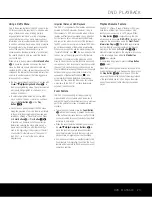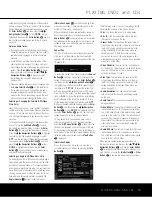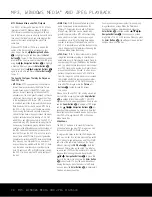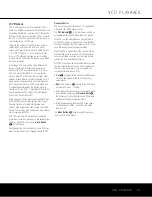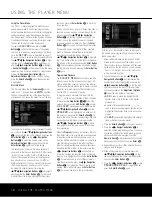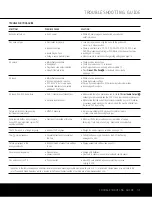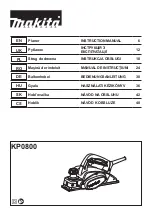
Before proceeding with the audio setup adjustments
using the DVD 31’s controls, we recommend that you
first use the menu system in your receiver and proces-
sor to access the settings already established for
“Speaker Size,” “Output Level” and “Delay Time.” Write
these settings down, as you will use them during the
configuration process.
As with all setup menus, press the
OSD Button
`
to activate the main menu screen, and then press
⁄
/
¤
Navigation
e
so that
SETUP
is high-
lighted. Then use the
⁄
/
¤
/
‹
/
›
Navigation Buttons
e
until the
AUDIO ADJUSTMENTS
Submenu
∫
is highlighted within a white outline box
and press
Enter
z
.
The following adjustments are available on the
AUDIO ADJUSTMENTS
menu for each
speaker position. Although some of the adjustments
work in speaker pairs, it is recommended that you
cycle through the adjustments for each speaker posi-
tion using the
⁄
/
¤
/
‹
/
›
Navigation Buttons
e
to
enter the settings that are appropriate for your system.
Speaker Size:
Speaker size is part of the bass man-
agement system which determines which frequencies
are sent to the specific speaker position, and which
are sent to the subwoofer. The designation of “size”
does not refer to the speaker’s physical size, but rather
to the lowest frequency a speaker can handle. For this
purpose, “full-range” speakers are considered “large,”
while those not capable of reproduction below 100Hz
are considered “small.” In general, if you are using a
packaged speaker system with smaller satellite-type
speakers and a subwoofer, you should select
Small
.
Large
should only be selected if you
are certain that your speakers are capable of handling
extreme low-frequency sounds.
Note that the speaker size for the Front Left and Front
Right, and Surround Left and Surround Right positions
are adjusted as pairs. When you change the setting for
the left speaker in either the front or surround posi-
tions, the right speaker changes to that setting, and
vice versa.
For the subwoofer, the settings are slightly different.
Select
On
when a subwoofer is connected, or
Off
if one is not used. The second setting for the sub-
woofer is the crossover. This determines which sounds
will be sent to the subwoofer, and which to the main
speakers when
Small
is selected as the speaker
size for any of the speakers. Select the frequency from
those shown on the
Adjustments Options Line
É
that is closest to the lowest frequency your main
(left/center/right/surround left/surround right) speakers
are able to reproduce. If you are not familiar with that
information, it may be found in the owner’s manual for
your speakers.
Delay Time:
This setting is used to compensate for
the time it takes for sound to reach you from each
speaker position. Select the distance from the speaker
to your listening position by choosing one of the dis-
tance settings shown on the
Adjustments Options
Line
É
. This setting is not available for the sub-
woofer.
Output Level:
This setting is used to maintain bal-
anced reproduction and sound field presentation. The
goal is to make certain that a sound of identical level
is heard from each speaker position. The best way to
do this is to enter the same speaker level output set-
tings already established by your receiver and proces-
sor. Alternatively, you may use a test disc that outputs
a fixed tone to all speakers at the same time and
adjust the settings here so that the tone is heard at the
same level from all speakers.
Video Setup Menu
This menu establishes the DVD’s configuration for
video format settings such as aspect ratio and
output scan.
As with all setup menus, press the
OSD Button
`
to activate the main menu screen, and then press the
‹
/
›
Navigation Buttons
e
so that
SETUP
is
highlighted. Press the
Enter Button
z
, and then
use the
K
/
L
/
‹
/
›
Navigation Buttons
e
until
the
VIDEO SETUP
menu is highlighted within
a white outline and press the
Enter Button
z
again. Finally, press the
‹
/
›
Navigation Buttons
e
once more to move the highlight to the
Control
Settings
ç
side of the menu screen.
The following adjustments are available on the Video
Setup menu:
Aspect Ratio:
This setting selects the aspect ratio
of video programming. Your choice should be made
according to the shape of your video display and your
personal preferences. Three choices are available:
•
16:9:
If you have a widescreen (16:9) display, or a
display that has a widescreen mode, choose this
setting. With this setting, the DVD 31 will adjust the
output for widescreen movies so that they fill the
entire screen in the proper aspect ratio. Note, how-
ever, that in this setting a disc recorded in the 4:3
aspect ratio will appear in the widescreen as a
boxed image in the center, with black columns on
the left and right side of the screen. Note that if the
widescreen option is chosen and a widescreen
movie is played on a conventional 4:3 aspect ratio
set, the image will be distorted due to vertical com-
pression.
•
Letterbox:
If you have a standard, 4:3 aspect ratio
video display, choose this setting if you wish to see
the entire frame of the movie as it is recorded on
the disc without any image cutoff at the left and
right sides. While this allows widescreen movies to
be shown in their entirety, they will occupy a smaller
portion of the screen and black “letterbox” bars may
appear at the top and bottom of the screen.
•
PanScan:
If you have a standard, 4:3 aspect ratio
video display and prefer to have widescreen movies
displayed without the black bars at the top and bot-
tom of the screen, choose this option. Note, how-
ever, that since most DVDs do not contain special
“pan/scan” coding that allows the on-screen image
to follow the action, you may find that while the
image will fill the screen, the vertical spread will
cause it to be cropped at the left and right side.
Scan Type:
This setting allows you to select
between progressive and interlaced scanning for the
Component Video Outputs
∞
to maximize the
image resolution for the type of video display in use.
When all desired setup and configuration entries have
been made, press the
OSD Button
`
to return
the player to normal operation and you are ready to
enjoy the finest in DVD or CD playback! Note that the
output at the
S-Video
∞
and
Composite Video
§
outputs will always be standard-rate video that is
compatible with any television set or video display.
Two choices are available:
•
Progressive:
Select this option if you have a video
display that is compatible with input sources of
480P or greater. Displays labeled as “HDTV Ready,”
including virtually all large-screen LCD and plasma
displays, are compatible with progressive scan.
•
Interlaced:
Select this option when you are using
an older video display that has Y/Pr/Pb component
inputs, but which is not capable of displaying high
scan rate, or “HD” signals.
Video Mode:
This setting affects only the
Com-
ponent Video Outputs
∞
, and it controls how the
video signals are optimized for progressive scan dis-
play. In most cases, the “automatic” mode is your best
choice, as it senses whether the disc being played was
SYSTEM SETUP
20 SYSTEM SETUP
DVD 31 (120V) OM 6/25/04 11:40 AM Page 20


















